Unveiling Russia’s Architectural Marvels: A Journey Through History and Design
Have you ever paused to consider the profound stories embedded within the very structures that define a nation’s skyline? Russia, a country renowned for its immense scale and rich, multifaceted history, boasts an extraordinary collection of buildings that are far more than mere constructions. They are enduring testaments to centuries of tsarist grandeur, Soviet ambition, and modern innovation, each one a unique blend of diverse architectural influences that collectively forge a distinctly Russian identity.
Embarking on a journey to discover these iconic landmarks offers more than just sightseeing; it provides a profound understanding of Russia’s complex soul. As you traverse through time, from the opulent imperial palaces to the awe-inspiring cathedrals and grand public works, you will witness firsthand how pivotal historical events have sculpted the nation’s architectural landscape. These magnificent structures serve as vibrant bridges, seamlessly merging Russia’s storied past with its dynamic present, inviting travelers to delve deeper into its cultural tapestry.
Prepare to be captivated by the sheer artistry and historical depth of Russia’s most famous buildings. Keep reading to explore these architectural wonders and uncover the fascinating narratives they hold!
Why Russian Architecture Stands Out: A Symphony of Styles
Russian architecture occupies a truly unique and significant position in the annals of world design history. Its evolution is a captivating narrative, beginning with the simple yet resilient wooden structures of ancient Rus, which laid the foundational understanding of building in challenging climates. This early tradition took a monumental turn with the adoption of Orthodox Christianity in the 10th century, ushering in an era of majestic stone churches inspired by Byzantine models. This foundational blend of indigenous ingenuity and sophisticated Eastern Roman influences is precisely what imbues Russian buildings with their unparalleled distinctiveness.
The sheer geographical expanse of Russia allowed for the organic development of a myriad of regional styles, each reflecting local resources, traditions, and artistic expressions. From the whimsical, vibrant patterns and onion domes characteristic of Moscow’s medieval churches to the elegant, classical grace imported from Western Europe that defines St. Petersburg, the architectural diversity is astounding. Russian buildings bear the unmistakable imprints of various historical epochs, showcasing a remarkable ability to absorb and transform external influences.
The early Byzantine church designs, with their central plans and domed roofs, profoundly shaped Russian religious architecture. Later, influences from the East, particularly in decorative elements and the use of vibrant colors, added an exotic richness. Then, with the reforms of Peter the Great in the 18th century, Russian cities began to consciously emulate the grand, ordered urban planning and Baroque aesthetics of Western European capitals. This period of intense Europeanization was followed by a resurgence of national pride in the 19th century, giving rise to the Russian Revival style, which looked back to pre-Petrine architectural forms for inspiration. The Soviet era, in turn, introduced monumental Socialist Classicism and later functionalist blocks, each reflecting the ideological imperatives of the time. Today, modern designs continue to push boundaries, often integrating contemporary elements while nodding to historical motifs.
What truly elevates Russian architecture and sets it apart on the global stage is its audacious use of color, its often fantastical and unusual shapes, and its unparalleled ability to harmoniously blend seemingly opposing styles. The stark yet compelling contrast between the humble, functional wooden homes found in traditional villages and the extravagant, gilded palaces that dominate the cities vividly illustrates the breadth and depth of Russia’s architectural imagination. These buildings are not merely beautiful structures; they are potent, tangible symbols of Russia’s complex history, its spiritual depth, and its enduring cultural position at the crossroads of East and West, constantly mediating and reinventing these influences.
Top Buildings You Must See in Russia: A Curated Selection
1. St. Basil’s Cathedral – Moscow’s Colorful Landmark
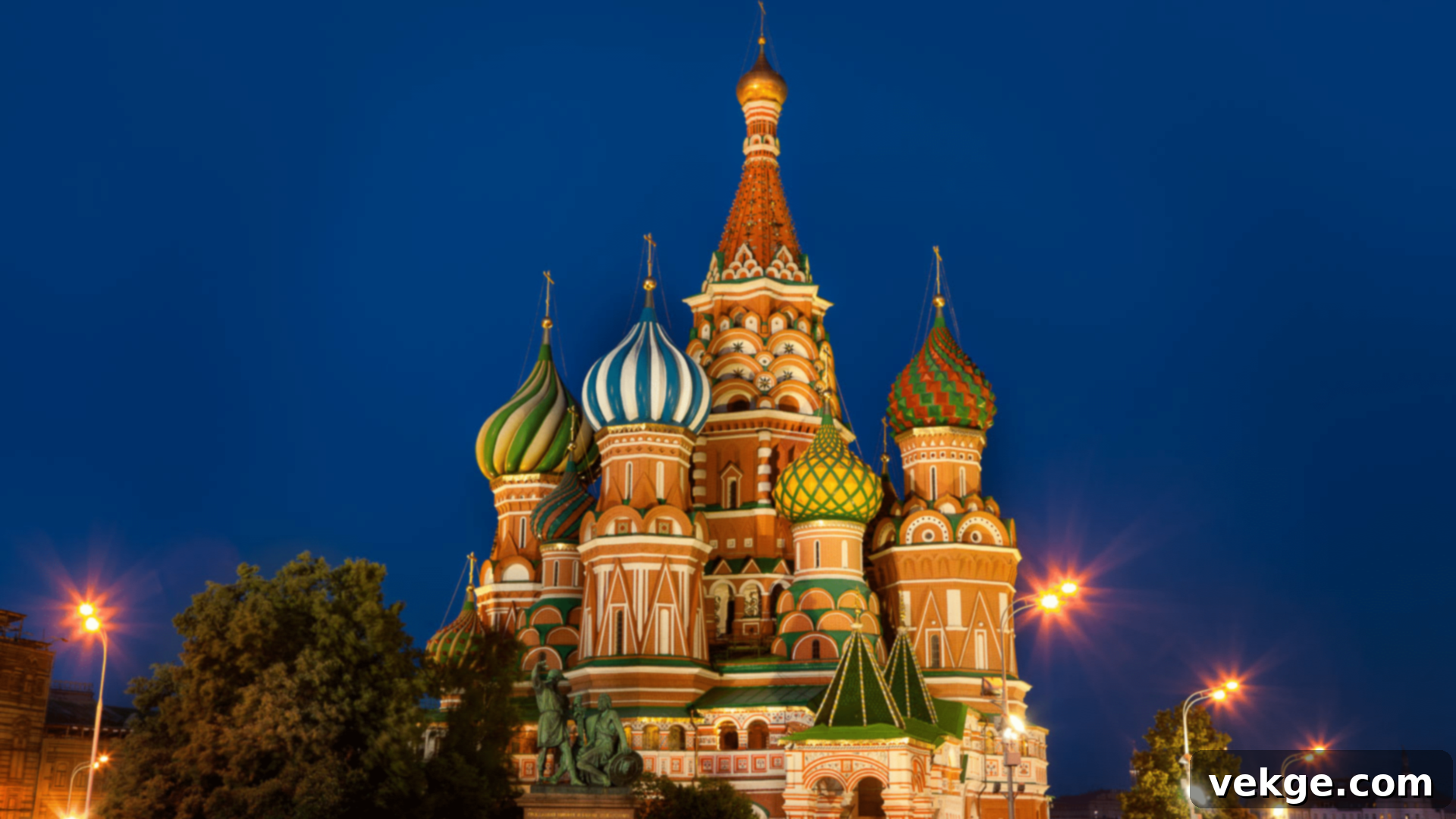
Standing proudly at the southern end of Red Square, St. Basil’s Cathedral is arguably the most iconic symbol of Russia. Commissioned by Ivan the Terrible in the mid-16th century (1555–1561) to commemorate his conquest of Kazan and Astrakhan, its kaleidoscopic domes and an intricate array of shapes make it instantly recognizable and unlike any other religious structure in the world. The cathedral’s design is a profound reflection of medieval Russian architecture, with deep spiritual symbolism embedded in its form, though its exact architectural inspiration remains a subject of historical debate.
- Architectural Style: A unique blend of Russian Orthodox tented roofs and vibrant onion domes, often seen as a pinnacle of Russian national architecture. Its intricate, almost fantastical appearance is said to represent the Heavenly Jerusalem.
- Historical Significance: Built to commemorate the capture of Kazan and Astrakhan, pivotal victories that expanded the Russian state. Legend has it that Ivan the Terrible blinded the architects to prevent them from creating anything as beautiful again.
- Nearby Attractions: Red Square (a UNESCO World Heritage site), the formidable Moscow Kremlin, and the historic GUM Department Store.
Visiting Tips:
- Arrive early in the morning, especially during peak season, to experience its awe-inspiring interior and avoid the large crowds.
- The best photo opportunities are from various points within Red Square, as well as from the elevated paths of the nearby Zaryadye Park, which offer panoramic views.
- Take your time inside to appreciate the individual chapels, frescoes, and iconostasis that make up this complex structure.
2. Winter Palace – The Grand Imperial Residence
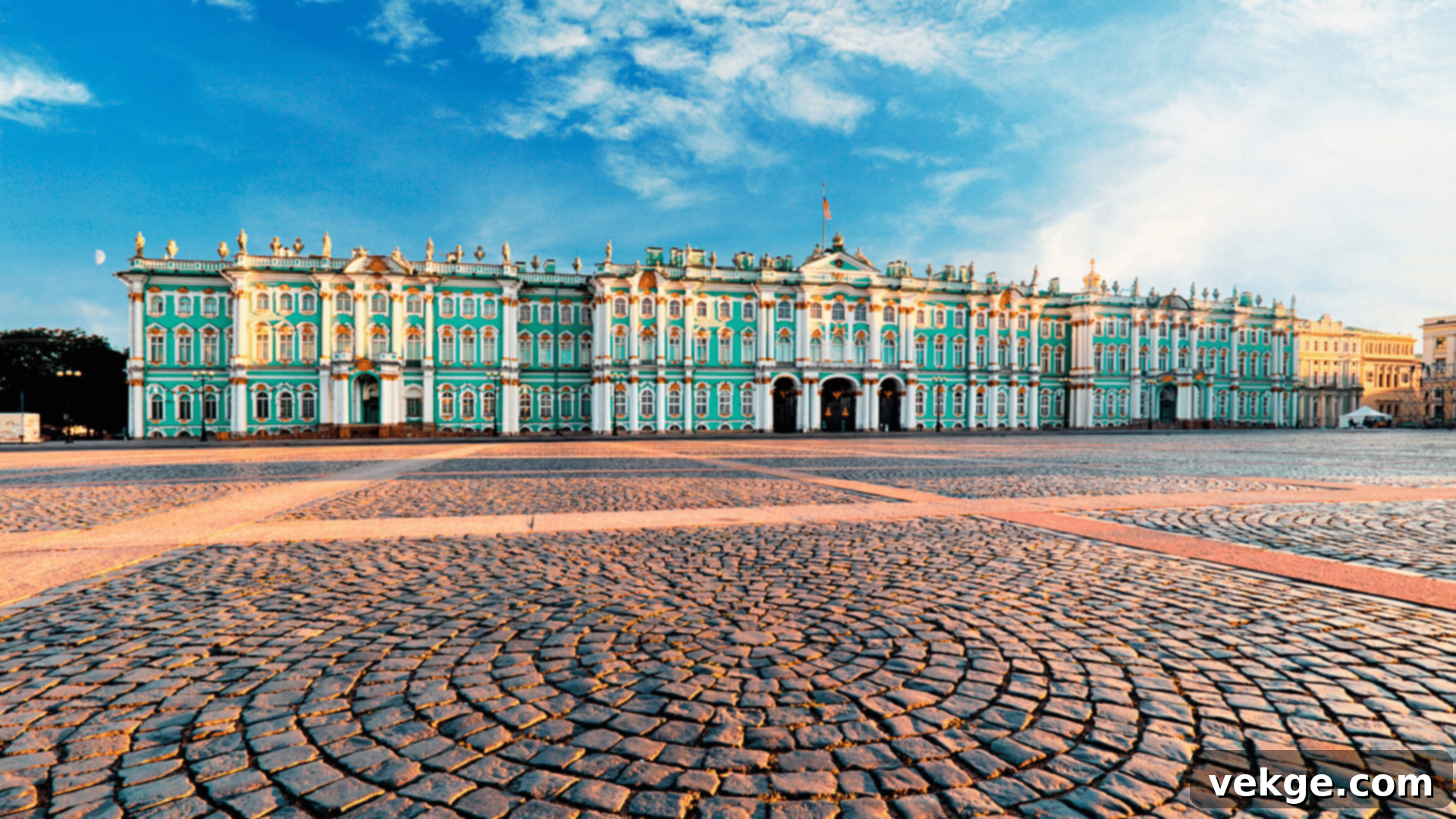
Dominating Palace Square in St. Petersburg, the emerald-green and white Winter Palace served as the official residence of Russian emperors from the 1730s until the 1917 Russian Revolution. This colossal Baroque masterpiece, primarily designed by Bartolomeo Francesco Rastrelli, is a testament to the unparalleled opulence and power of the Romanov dynasty. Today, its vast halls and lavishly decorated rooms house a significant portion of the world-renowned State Hermitage Museum, boasting an extraordinary collection of over three million artworks, including masterpieces from artists like Rembrandt, Leonardo da Vinci, Raphael, and Michelangelo.
- Architectural Style: Quintessential Russian Baroque, characterized by elaborate facades, ornate sculptures, grand staircases, and rich interior decoration, reflecting 18th-century European royal aesthetics.
- Historical Significance: The primary residence of Russian tsars for nearly two centuries, it was the focal point of imperial rule and witnessed numerous pivotal events, including the dramatic storming during the 1917 revolution.
- Nearby Attractions: The expansive Palace Square, the elegant Admiralty Building, and the bustling Nevsky Prospect, St. Petersburg’s main thoroughfare.
Best Times to Visit:
- Consider visiting during the off-season (late fall or early spring) to experience the museum and palace with fewer tourists and shorter queues.
- Arriving immediately at opening time in the morning is highly recommended for a quieter and more contemplative experience within the vast museum complex.
- Allocate at least a full day, or even two, to adequately explore the Hermitage Museum’s immense collections.
3. Peterhof Palace – The Russian Versailles
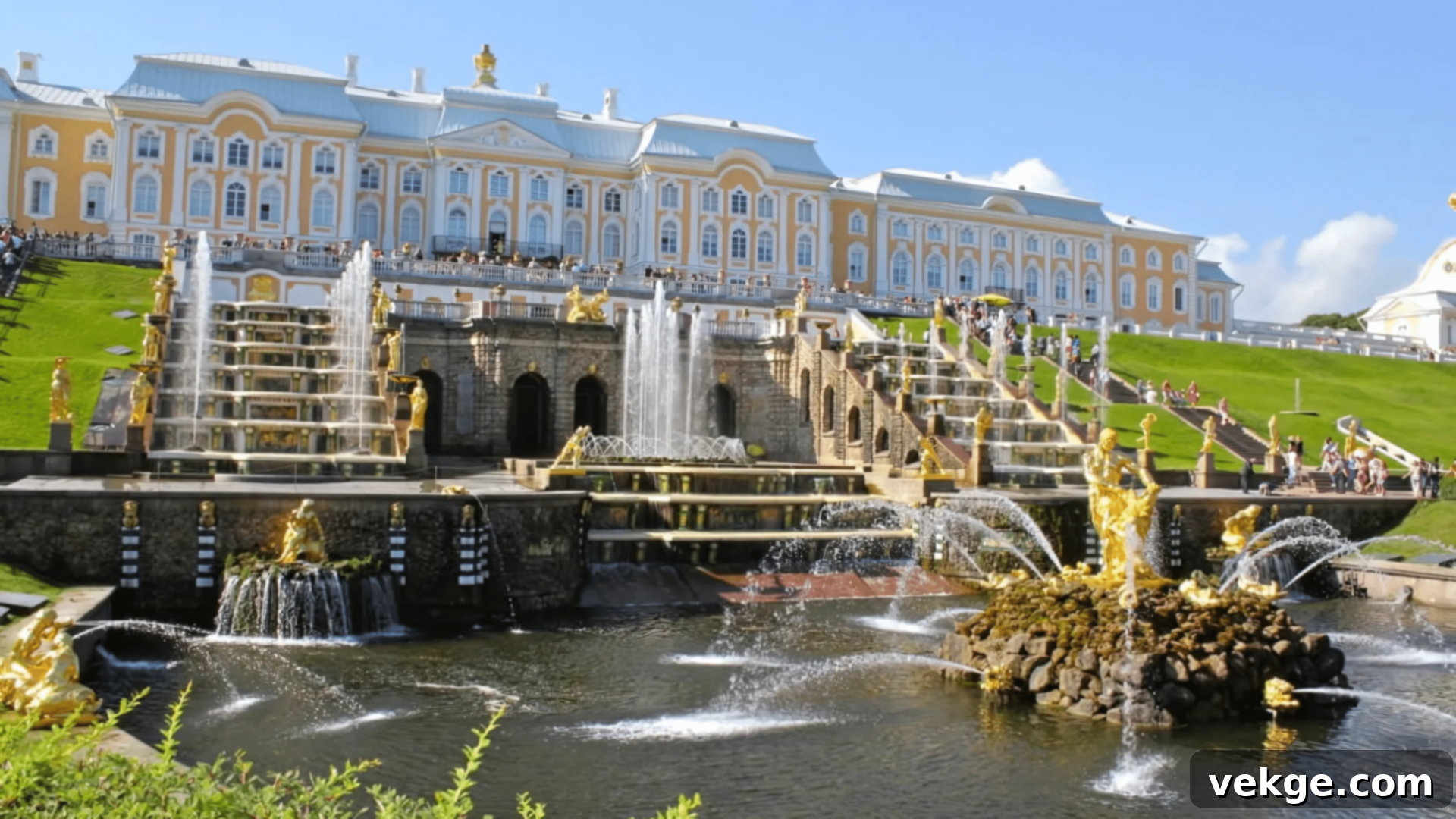
Nestled on the shores of the Gulf of Finland, just outside St. Petersburg, Peterhof Palace is often dubbed the “Russian Versailles” due to its breathtaking grandeur and meticulously landscaped grounds. Commissioned by Peter the Great in the early 18th century as a direct challenge to the French monarch’s famous estate, it is celebrated for its elaborate, sprawling gardens and the spectacular Grand Cascade. This intricate system of over 150 fountains and four waterfalls, featuring gilded statues and powerful jets, operates entirely without pumps, relying solely on natural hydrostatic pressure—an engineering marvel of its time. The palace interiors themselves are a dazzling display of lavish decorations, intricate gilded moldings, and priceless artwork spanning several centuries.
- Architectural Style: Predominantly Baroque, characterized by its majestic palace, numerous pavilions, and meticulously designed gardens with elaborate fountains and terraces cascading towards the sea.
- Historical Significance: Built as a potent symbol of Russia’s newly acquired naval strength and its ambition to rival the great European powers, embodying Peter the Great’s vision for a modern, European Russia.
- Nearby Attractions: The serene Gulf of Finland, the more intimate Monplaisir Palace (Peter the Great’s favorite retreat), and the tranquil Alexandria Park.
Seasonal Differences:
- Summer (May to September) offers the most vibrant experience, with all the fountains in full, glorious operation, creating a truly unforgettable spectacle.
- Winter provides a quieter, perhaps more contemplative visit, as the fountains are turned off, but the snow-covered landscape offers a unique, serene beauty and fewer crowds.
- Consider a hydrofoil boat trip from St. Petersburg to Peterhof in summer for a scenic arrival.
4. Catherine Palace – The Blue Marvel of St. Petersburg
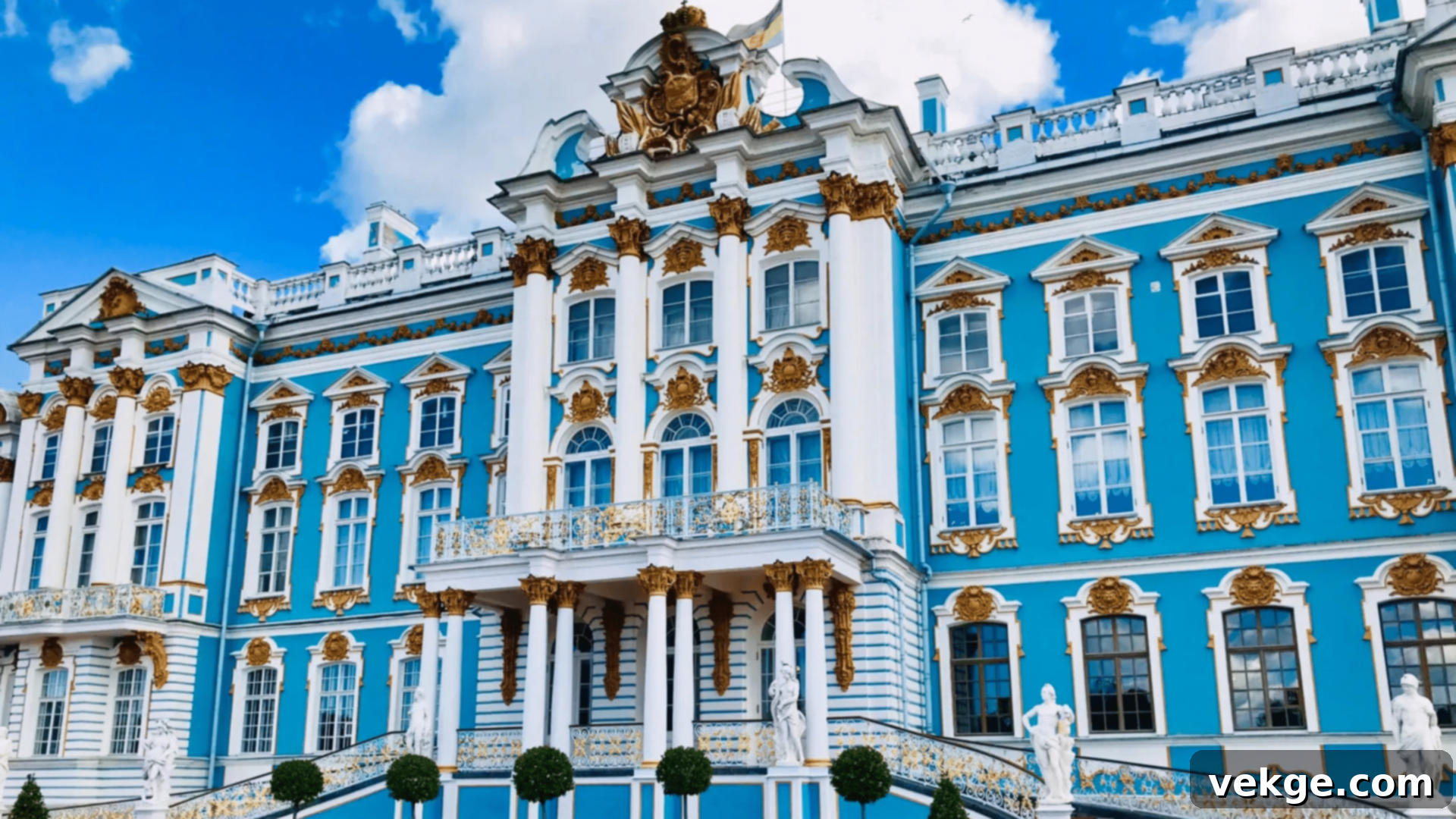
Located in the town of Pushkin (formerly Tsarskoye Selo), Catherine Palace is a stunning example of Rococo architecture, instantly recognizable by its striking blue and white exterior, adorned with golden details. Originally built for Catherine I, the wife of Peter the Great, it was later expanded and lavishly decorated under Empress Elizabeth and Catherine the Great. The palace’s most famous and awe-inspiring feature is undoubtedly the Amber Room, a chamber entirely paneled in amber, gold leaf, and mirrors. Lost during World War II, it was meticulously reconstructed over decades and remains one of its most visited and breathtaking attractions. The sprawling surrounding gardens, a mix of formal French and picturesque English styles, further enhance its regal appeal.
- Architectural Style: Exquisite Rococo, characterized by its ornate ornamentation, intricate gold detailing, and lavish, often whimsical, gilded interiors that reflect aristocratic elegance.
- Historical Significance: Served as the magnificent summer residence of Russian tsars, a place of relaxation and grand state receptions away from the capital.
- Nearby Attractions: The historic Tsarskoye Selo park, the more restrained Alexander Palace (the last residence of Nicholas II), and the charming Pushkin Town.
Highlights:
- The Grand Hall, or Great Hall, with its dazzling display of mirrors, frescoes, and intricate gold detailing, designed for imperial balls and receptions.
- A leisurely stroll through the extensive Catherine Park, which features charming pavilions, bridges, and picturesque landscapes.
- Pre-booking tickets, especially for the Amber Room, is highly recommended to secure your entry.
5. Moscow Kremlin – Russia’s Historic Fortress and Seat of Power
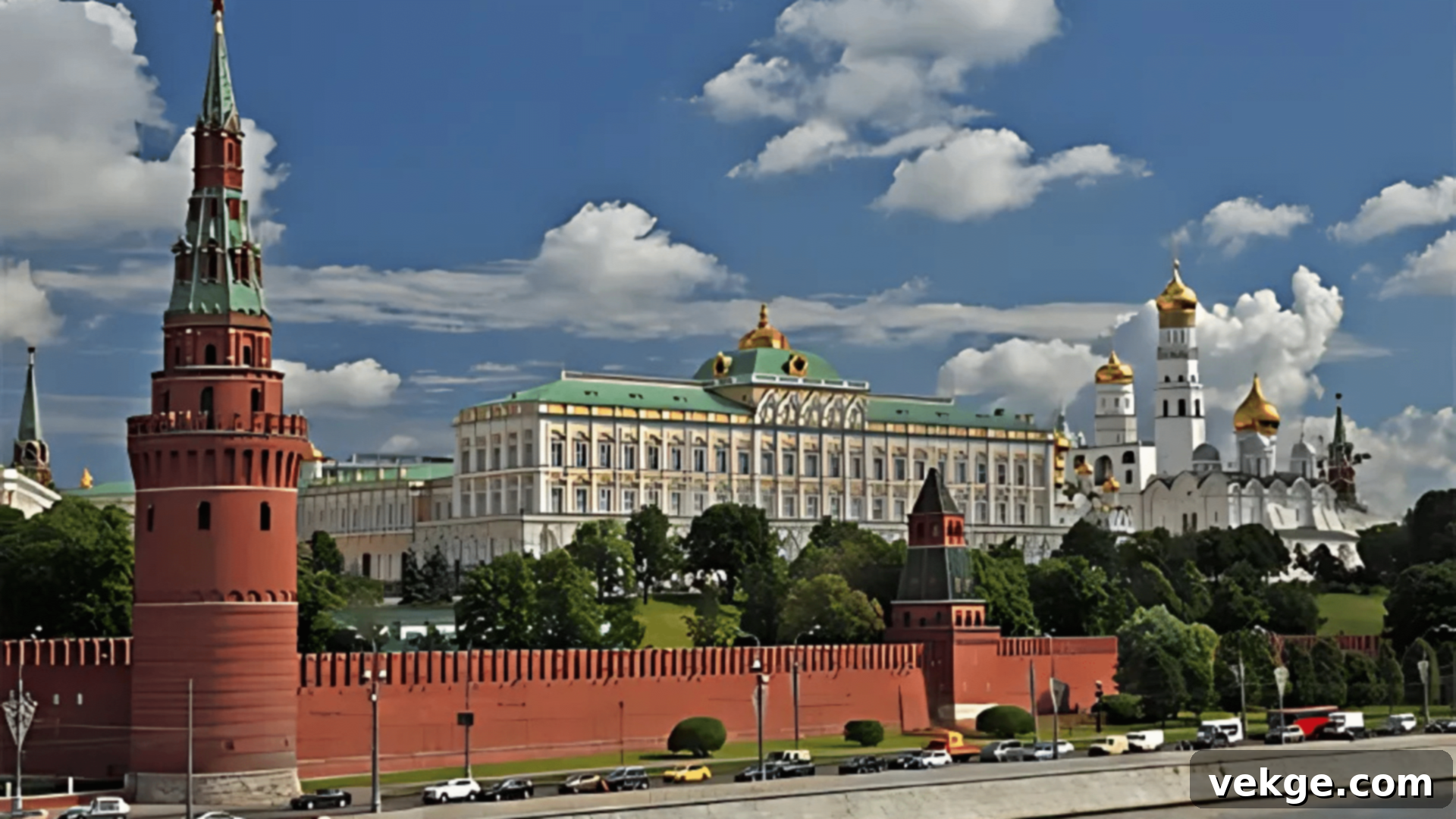
The Moscow Kremlin is not just a building, but a fortified complex nestled in the very heart of Moscow, overlooking the Moskva River and Red Square. This iconic fortress, with its distinctive red brick walls and twenty towers, has been the epicentre of Russian power since the 13th century. Within its triangular walls lie a treasure trove of historical significance, housing not only government buildings but also grand palaces, magnificent cathedrals, and museums. Its towering walls and watchtowers, some dating back to the 15th century, symbolize Russia’s enduring political might, its profound historical narrative, and its spiritual heritage.
- Architectural Style: A blend of medieval Russian fortress architecture with Renaissance influences, particularly visible in the design of its cathedrals and palaces, featuring elements like arcades and Italianate details.
- Historical Significance: The historical and political heart of Moscow and Russia, serving as the seat of the Grand Dukes of Moscow, later the Tsars, the Soviet government, and today, the President of the Russian Federation.
- Nearby Attractions: The vast Red Square, the solemn Lenin’s Mausoleum, and the vibrant St. Basil’s Cathedral.
Must-See Areas:
- The Armory Museum, an imperial treasury that houses an astounding collection of state regalia, royal carriages, Faberge eggs, and weapons.
- Cathedral Square, the spiritual heart of the Kremlin, surrounded by three stunning cathedrals: Dormition, Archangel, and Annunciation, each with unique historical and artistic importance.
- The Ivan the Great Bell Tower, offering panoramic views (seasonal access).
6. Bolshoi Theater – Home of Russian Ballet and Opera
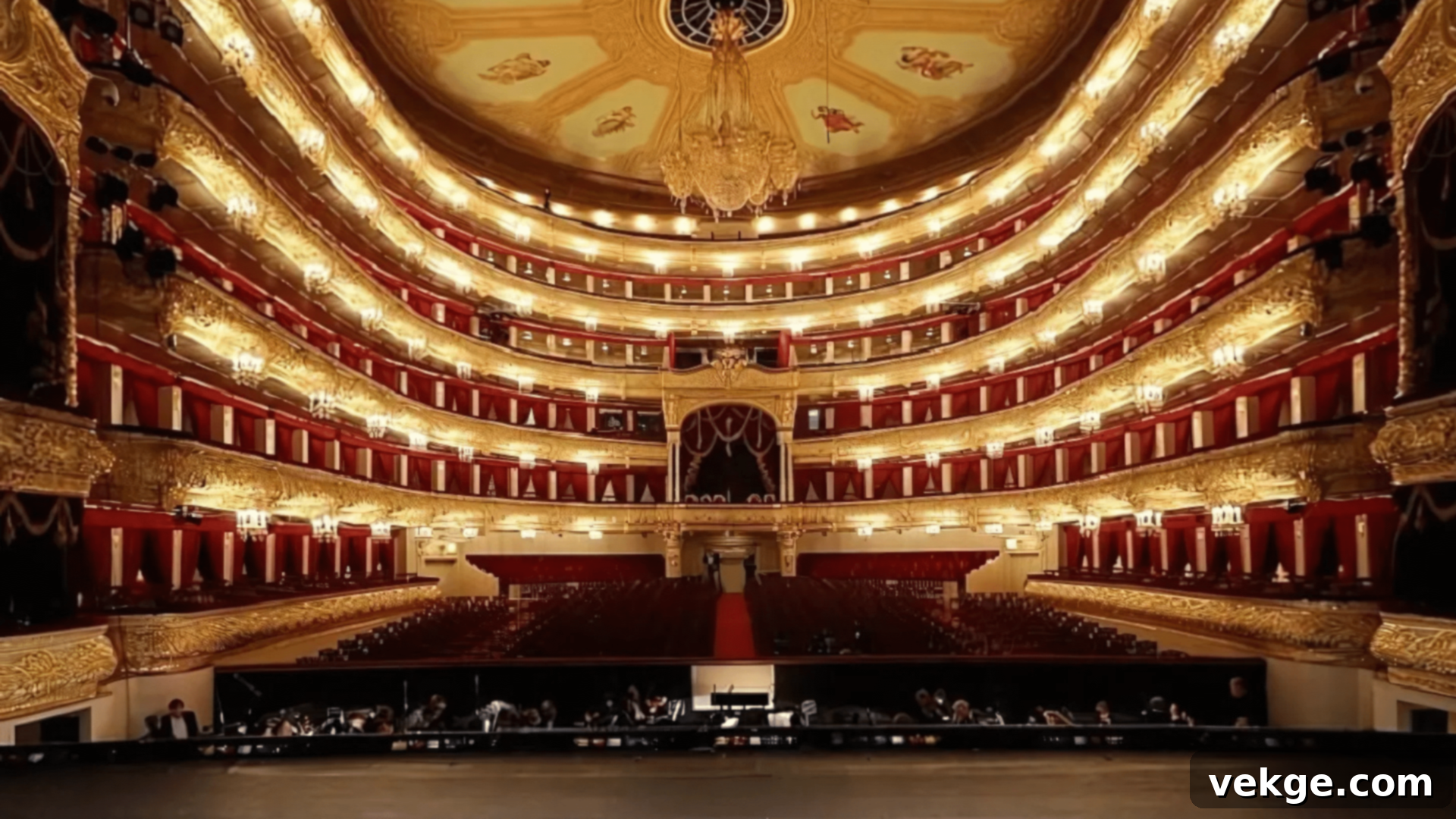
Since its establishment in 1776, the Bolshoi Theater in Moscow has stood as a global beacon for classical ballet and opera. Although the current neoclassical edifice, built between 1821 and 1825, has undergone several significant reconstructions and restorations, particularly a massive renovation completed in 2011, its majestic design remains a masterpiece of theatrical architecture. The interior is a symphony of exquisite chandeliers, intricate stucco work, and a lavish main hall adorned in crimson and gold, providing a truly opulent setting for world-class performances. It’s not just a venue; it’s a living institution that has shaped the history of performing arts.
- Architectural Style: Grand Neoclassical, characterized by its monumental columns, classical pediment, and an ornate, richly decorated interior designed to impress and inspire.
- Historical Significance: A leading and internationally revered stage for Russian ballet and opera, it has premiered countless iconic works and fostered generations of legendary artists.
- Nearby Attractions: The vibrant Tverskaya Street (Moscow’s main artery), the historic Revolution Square, and the tranquil Alexander Garden.
Performance Tips:
- Given its global reputation, tickets for performances, especially ballets like “Swan Lake” or “The Nutcracker,” should be purchased well in advance (often months ahead) directly from the official website.
- Dressing formally (smart casual to evening wear) is part of the traditional etiquette and enhances the experience of visiting this esteemed venue.
- Consider taking a guided tour of the building itself to appreciate its history and architectural details even without attending a performance.
7. Cathedral of Christ the Savior – Moscow’s Tallest Orthodox Church
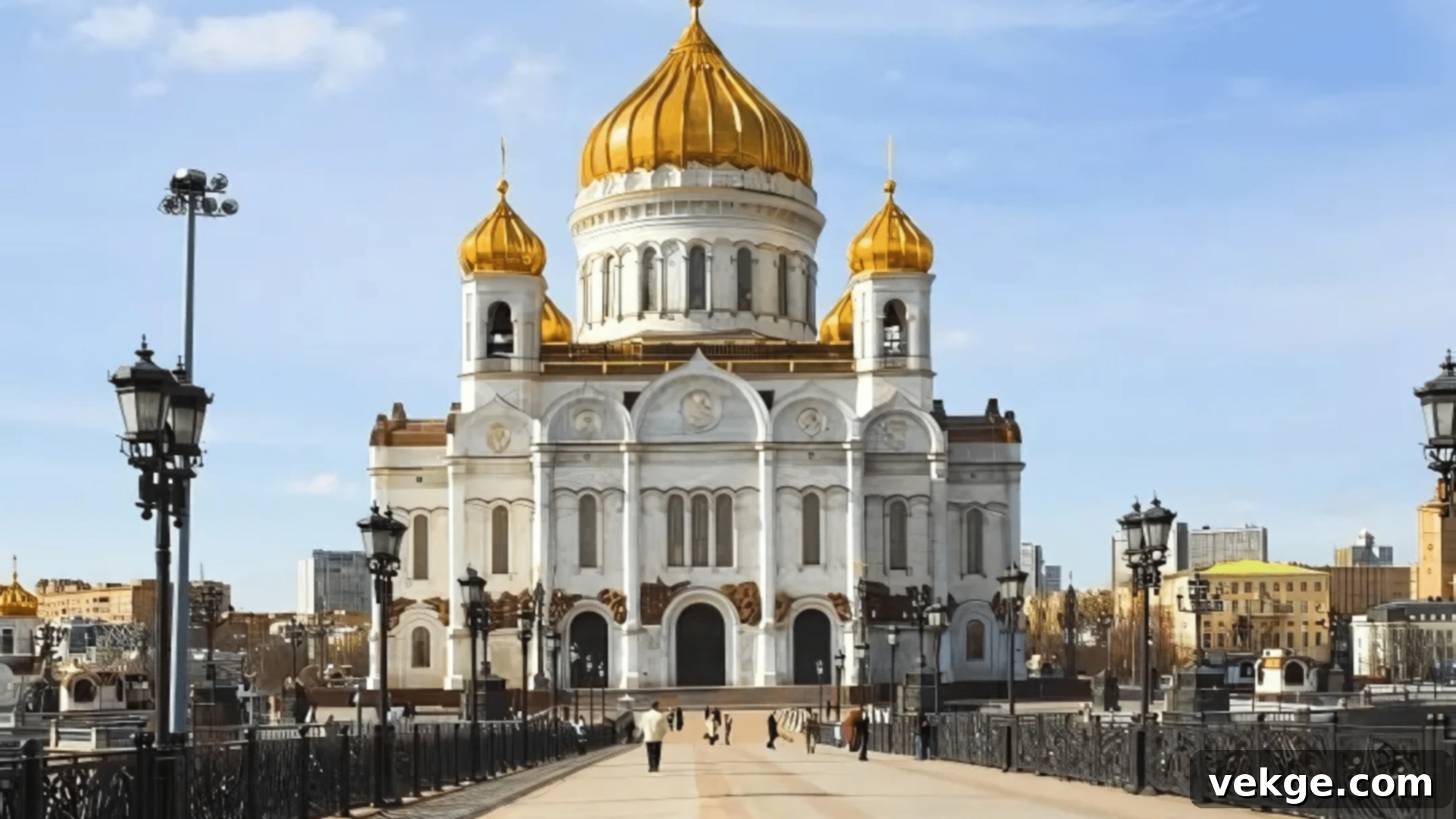
The Cathedral of Christ the Savior, with its dazzling white walls and glistening golden domes, is a dominant feature of the Moscow skyline. Its history is a remarkable tale of destruction and resurrection. Originally conceived in the 19th century to commemorate Russia’s victory over Napoleon’s invasion, it was completed in 1883, only to be tragically demolished in 1931 during the Soviet era. A meticulous and faithful reconstruction was undertaken in the late 20th century, concluding in 2000, bringing this spiritual landmark back to life. Today, it stands as the tallest Orthodox church in the world, a symbol of national resilience and religious revival.
- Architectural Style: Russian Revival, characterized by its towering domes, grand scale, and extensive use of frescoes and mosaics that evoke traditional Russian ecclesiastical art.
- Historical Significance: Built to commemorate the victory over Napoleon’s forces in 1812; its later demolition and precise reconstruction underscore significant shifts in Russian political and spiritual identity.
- Nearby Attractions: The pedestrian Patriarch’s Bridge offering excellent views, the historic Arbat Street, and the sprawling Gorky Park.
Visitor Information:
- The cathedral offers an observation deck (accessible via an elevator) that provides breathtaking panoramic views of Moscow, including the Kremlin and the Moskva River.
- As an active place of worship, visitors are expected to dress modestly, covering shoulders and knees. Women may be asked to cover their heads upon entry.
- The lower church houses a small museum detailing its history and reconstruction.
8. Moscow Metro Stations – Underground Palaces for the People
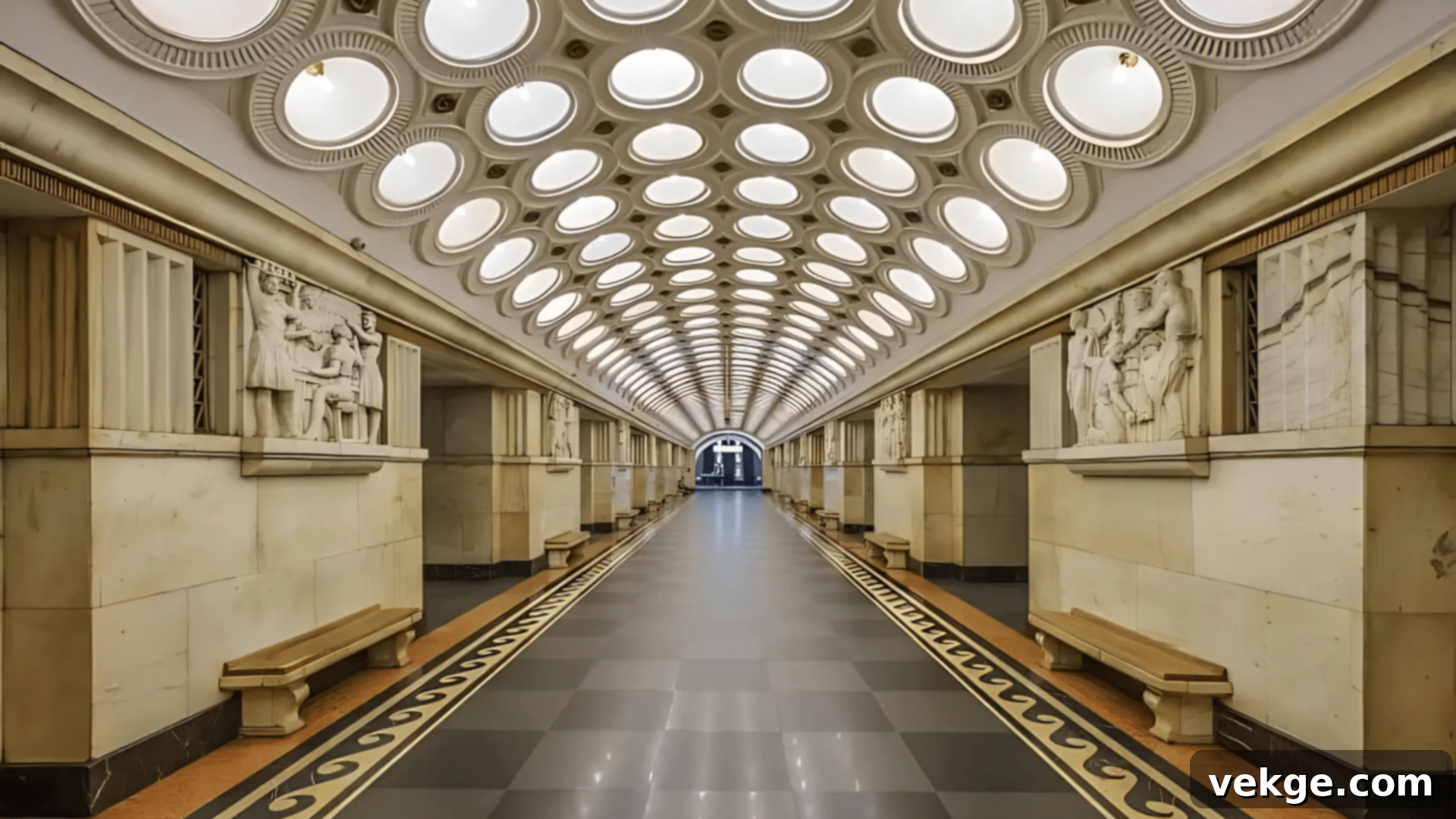
Far from being mere transportation hubs, Moscow’s metro stations are renowned worldwide as opulent underground palaces, veritable museums beneath the city streets. Conceived under Stalin’s rule in the 1930s as “palaces for the people,” these stations were designed to inspire and educate the masses, showcasing Soviet artistic and engineering prowess. Each station is a unique architectural marvel, featuring elaborate mosaics depicting Soviet heroes and achievements, magnificent chandeliers, intricate sculptures, polished marble, and stained-glass panels, making a journey on the Moscow Metro an unforgettable artistic experience in itself.
- Architectural Style: Primarily Socialist Classicism with strong Art Deco influences, blending monumental scale with decorative richness, often reflecting the specific themes of Soviet propaganda and national pride.
- Historical Significance: Built during the Soviet era to serve as both efficient transportation and ideological symbols, embodying the concept of accessible art and grandeur for the common citizen.
- Nearby Attractions: Various historically and artistically significant stations are conveniently located near major attractions like Red Square, Tverskaya Street, and other cultural sites.
Recommended Stations to Explore:
- Komsomolskaya (Circle Line): Famous for its baroque-style ceilings, mosaics celebrating Russian military victories, and grand chandeliers.
- Mayakovskaya (Zamoskvoretskaya Line): Known for its futuristic Art Deco design, stainless steel columns, and ceiling mosaics depicting “24 Hours of the Soviet Sky.”
- Novoslobodskaya (Circle Line): Remarkable for its 32 stained-glass panels illuminated from within, depicting peaceful scenes.
- Kievskaya (Circle Line): Celebrates the friendship between Russian and Ukrainian peoples with stunning frescoes and mosaics.
9. Kazan Cathedral – St. Petersburg’s Neoclassical Masterpiece
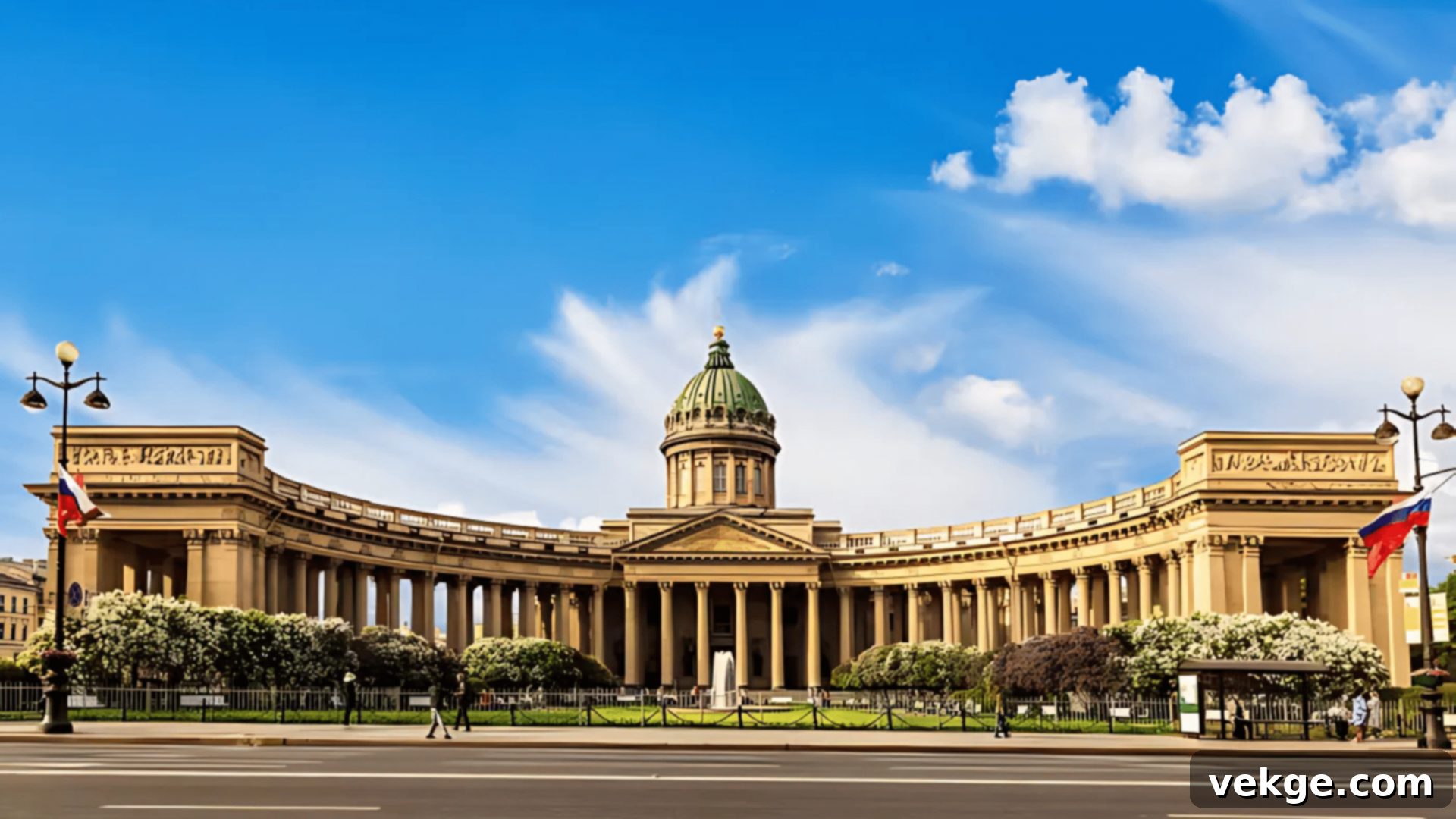
Stretching along Nevsky Prospect in St. Petersburg, Kazan Cathedral is an imposing Russian Orthodox church known for its magnificent semicircular colonnade, reminiscent of St. Peter’s Basilica in Vatican City. Built between 1801 and 1811 by architect Andrey Voronikhin, it was intended to be the principal church of the Russian Empire. Its expansive colonnade, composed of 96 Corinthian columns, embraces a small square, creating a truly grand and European feel. The richly decorated interior is equally impressive, featuring a stunning iconostasis and numerous works of art. Beyond its architectural beauty, Kazan Cathedral played a crucial role in Russian religious and military history, becoming a monument to Russian military glory after the Napoleonic Wars.
- Architectural Style: Grand Neoclassical, distinguished by its monumental scale, the sweeping semicircular colonnade, and classic architectural elements both inside and out.
- Historical Significance: A pivotal symbol of Russian Orthodoxy and national pride, it became a memorial to the Russian victory over Napoleon, housing military trophies and the tomb of Field Marshal Mikhail Kutuzov.
- Nearby Attractions: The bustling Nevsky Prospect, the whimsical Church of the Savior on Spilled Blood, and the Singer House (Dom Knigi).
Interior Features:
- The revered Icon of Our Lady of Kazan, one of Russia’s most sacred religious artifacts, believed to have miraculous powers.
- High, vaulted ceilings adorned with detailed frescoes and impressive sculptures, creating a sense of awe and spiritual grandeur.
- Numerous relics and a profound atmosphere of reverence, as it remains an active place of worship.
10. Peter and Paul Fortress – The Birthplace of St. Petersburg
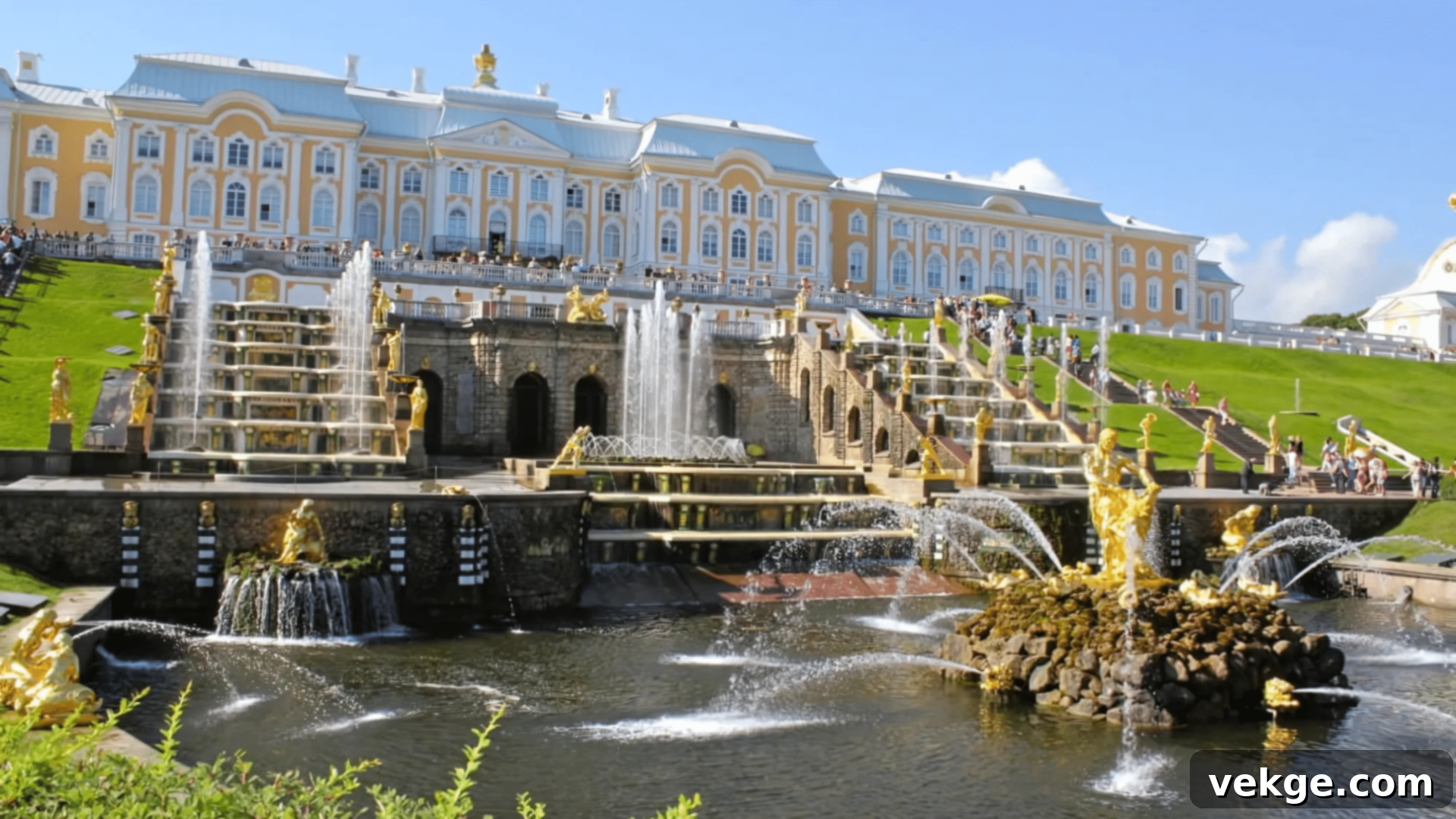
Perched on Zayachy Island in the Neva River, the Peter and Paul Fortress marks the precise spot where St. Petersburg was founded by Peter the Great in 1703. Initially conceived as a defensive bastion against Swedish attacks, the fortress never saw actual combat. Instead, it served for centuries as a notorious political prison, holding many prominent figures. At its heart stands the magnificent Peter and Paul Cathedral, whose slender golden spire, topped with a flying angel, is one of St. Petersburg’s highest landmarks. Inside the cathedral, visitors can find the tombs of almost all Russian emperors and empresses from Peter the Great to Nicholas II, making it the imperial necropolis.
- Architectural Style: Predominantly Baroque, characterized by its star-shaped fortified walls, bastions, and the distinctive golden spire of the cathedral, which became a symbol of the new imperial capital.
- Historical Significance: The very first structure built in St. Petersburg, marking the city’s foundation. It served as a vital military outpost, a political prison, and the burial place of the Romanov dynasty.
- Nearby Attractions: The scenic Neva River, the Kunstkamera (Russia’s first museum), and the historically significant Yusupov Palace.
What to See and Do:
- Explore the various museum exhibits detailing the fortress’s military history, its role as a prison, and the history of St. Petersburg.
- Witness the daily noontime cannon firing from the Naryshkin Bastion, a tradition that adds a touch of historical flair.
- Visit the Peter and Paul Cathedral to see the imperial tombs and admire its unique interior, including the magnificent Baroque iconostasis.
- Enjoy panoramic views of the Neva River and the city skyline from the fortress walls.
11. GUM Department Store – Shopping in Historic Grandeur

Situated directly opposite the Kremlin on Red Square, GUM (Glavny Universalny Magazin – Main Universal Store) is far more than just a shopping center; it’s an architectural landmark and a cultural institution. Built in the late 19th century (1893), its elaborate Russian Revival style facade and magnificent glass-roofed arcade create a truly unique shopping environment. The interior is divided into three grand passages, bathed in natural light, with multiple levels connected by elegant bridges and staircases. While it now houses modern high-end international brands and luxury boutiques, GUM remarkably retains much of its original grandeur and charm, offering a luxurious retail experience steeped in history, particularly vibrant during holidays.
- Architectural Style: A stunning example of Russian Revival, characterized by its intricate red brick facade, numerous turrets, and the innovative, soaring glass-and-steel arched roof that allows natural light to flood the interiors.
- Historical Significance: An iconic Soviet-era department store that was a symbol of state-controlled retail, and now a testament to Russia’s economic transformation, blending historical architecture with contemporary commerce.
- Nearby Attractions: The iconic Red Square, the solemn Lenin’s Mausoleum, and the vibrant St. Basil’s Cathedral are all just steps away.
Must-Try Experiences:
- Indulge in the famous GUM ice cream, a beloved Soviet-era treat that remains incredibly popular with visitors and locals alike, often sold from charming vintage kiosks.
- Visit the “Gastronom N°1” on the ground floor, a beautifully preserved Soviet-style deli that offers traditional Russian delicacies and gourmet products.
- Explore the historic dining hall for a taste of traditional Russian dishes in an authentic setting.
- Enjoy the seasonal decorations and events, especially around New Year and Christmas, which transform GUM into a magical wonderland.
Russia’s architectural wonders truly showcase its vast history, profound culture, and remarkable artistic achievements, offering a captivating journey through time and design.
Planning Your Russian Architectural Tour: Essential Tips
Best Times of Year to Visit
Choosing the right time to visit Russia can significantly enhance your architectural tour experience. The shoulder seasons of spring, from April to June, and fall, from September to October, generally offer the most pleasant conditions. During these periods, the weather is mild and comfortable for exploring on foot, and the tourist crowds are noticeably thinner compared to the peak summer months. Spring brings blossoming gardens, while fall dazzles with vibrant foliage, providing picturesque backdrops for historical sites. Winter, spanning from December to February, presents a truly magical, snow-covered landscape that lends an ethereal beauty to cathedrals and palaces. However, travelers must be thoroughly prepared for extremely cold temperatures, short daylight hours, and the possibility of heavy snow, though the festive atmosphere around holidays can be enchanting.
Transportation Between Cities and Within
Russia’s vastness necessitates efficient travel planning. For inter-city travel, high-speed trains are an excellent option. The “Sapsan” train, for instance, connects Moscow and St. Petersburg in under four hours, offering a comfortable and scenic journey. Overnight sleeper trains also provide a unique travel experience for longer distances. Domestic flights are ideal for covering the immense distances between major regions, such as flying to Kazan, Sochi, or cities in the Siberian expanse. Within major cities like Moscow and St. Petersburg, the metro systems are not only remarkably efficient, reliable, and affordable but are also famous for their ornate, museum-like station designs, making them an attraction in themselves. Taxis and ride-sharing apps are also widely available and convenient.
Photography Tips for These Iconic Landmarks
Capturing the grandeur of Russia’s architectural wonders requires a strategic approach to photography. Early morning hours and late afternoon, often referred to as the “golden hour,” provide the softest, most natural lighting, enhancing colors and textures while minimizing harsh shadows. A wide-angle lens is an invaluable tool for photographing grand structures like cathedrals and palaces, ensuring you can fit all the intricate details within the frame without distorting perspective too much. Look for unique angles, such as reflections in rivers, canals, or decorative fountains, which can innovatively enhance your images and add depth. Capturing buildings at night, when they are beautifully illuminated, offers a completely different, often more dramatic, perspective. Remember to be respectful in religious sites and check local rules regarding flash photography.
Guided Tours vs. Self-Exploration: Which is Right for You?
Deciding between guided tours and self-exploration depends on your travel style and preferences. Guided tours offer invaluable historical context, in-depth cultural insights, and often skip-the-line access, making them ideal for visitors who want detailed explanations of architectural features, historical events, and local legends from knowledgeable experts. This approach can be particularly beneficial for complex sites like the Kremlin or the Hermitage. Self-exploration, on the other hand, allows for a more flexible schedule, the freedom to linger at sites that capture your interest, and the joy of personal discovery at your own pace. For a balanced approach, consider utilizing audio guides, which are readily available at many major museums and historic sites. These provide structured learning combined with the independence of navigating on your own, offering the best of both worlds.
Conclusion: A Legacy Cast in Stone
Russia’s famous buildings are far more than just aesthetically pleasing structures; they are magnificent, tangible embodiments of the country’s profound and often tumultuous past. Each monument, from the whimsical, multi-domed grandeur of St. Basil’s Cathedral to the stately elegance of the Winter Palace, tells a compelling story, echoing centuries of imperial power, religious devotion, artistic innovation, and national resilience.
Visiting these extraordinary landmarks offers an unparalleled opportunity to connect deeply with Russia’s rich history and vibrant cultural heritage. You will experience firsthand the fascinating fusion of diverse cultural influences—Byzantine, European, and indigenous—that have converged to create a truly unique architectural identity. Whether you find yourself admiring the formidable walls of the Moscow Kremlin, marveling at the reconstructed splendor of the Catherine Palace, or descending into the artistic depths of the Moscow Metro, you will bear witness to the exceptional craftsmanship and visionary design that define Russian architecture.
These buildings are not merely sights to behold; they are essential journeys for anyone with an interest in history, art, and culture. They stand as enduring symbols, inviting you to explore, discover, and be inspired by the monumental legacy that Russia has cast in stone.
